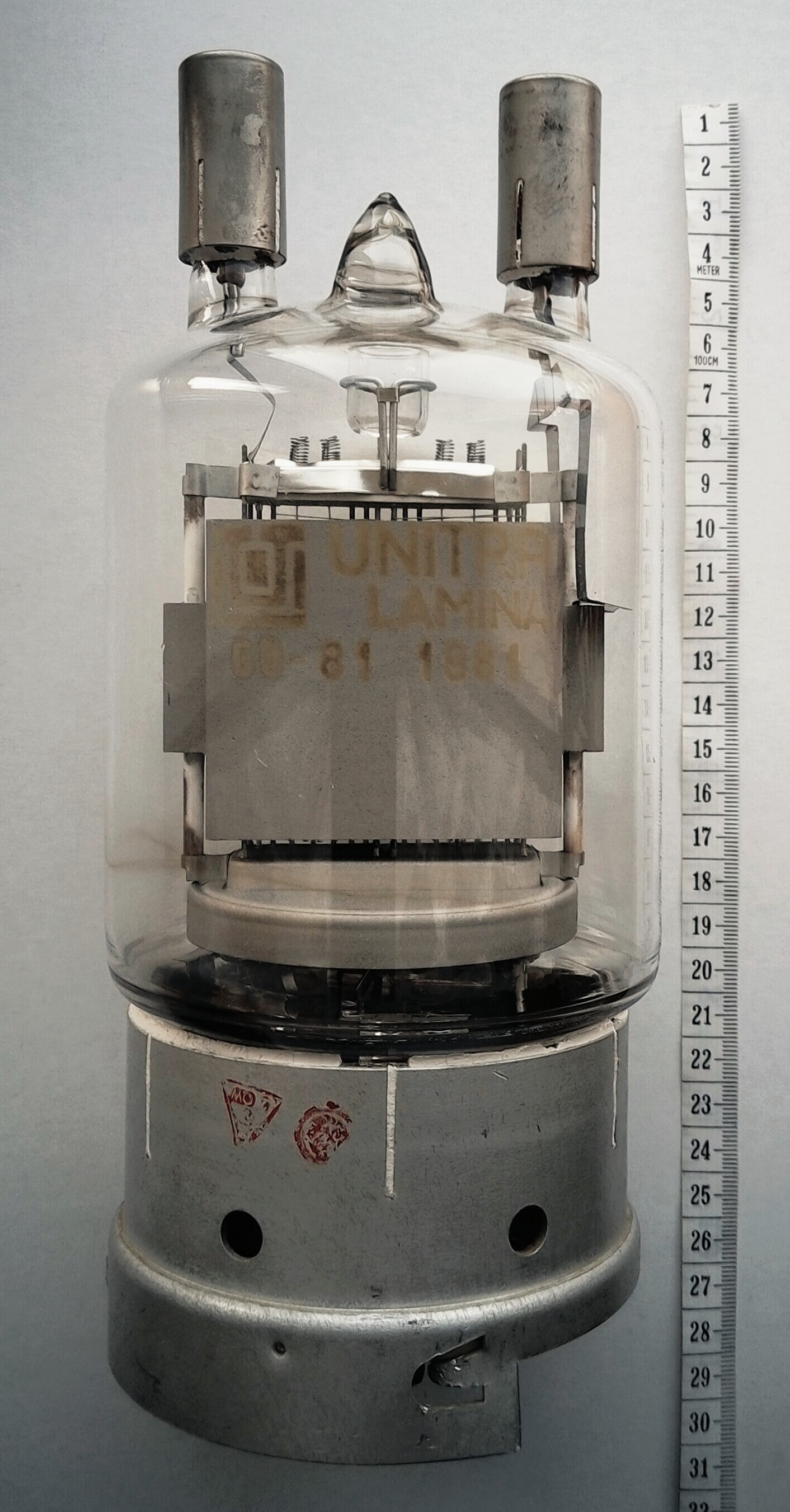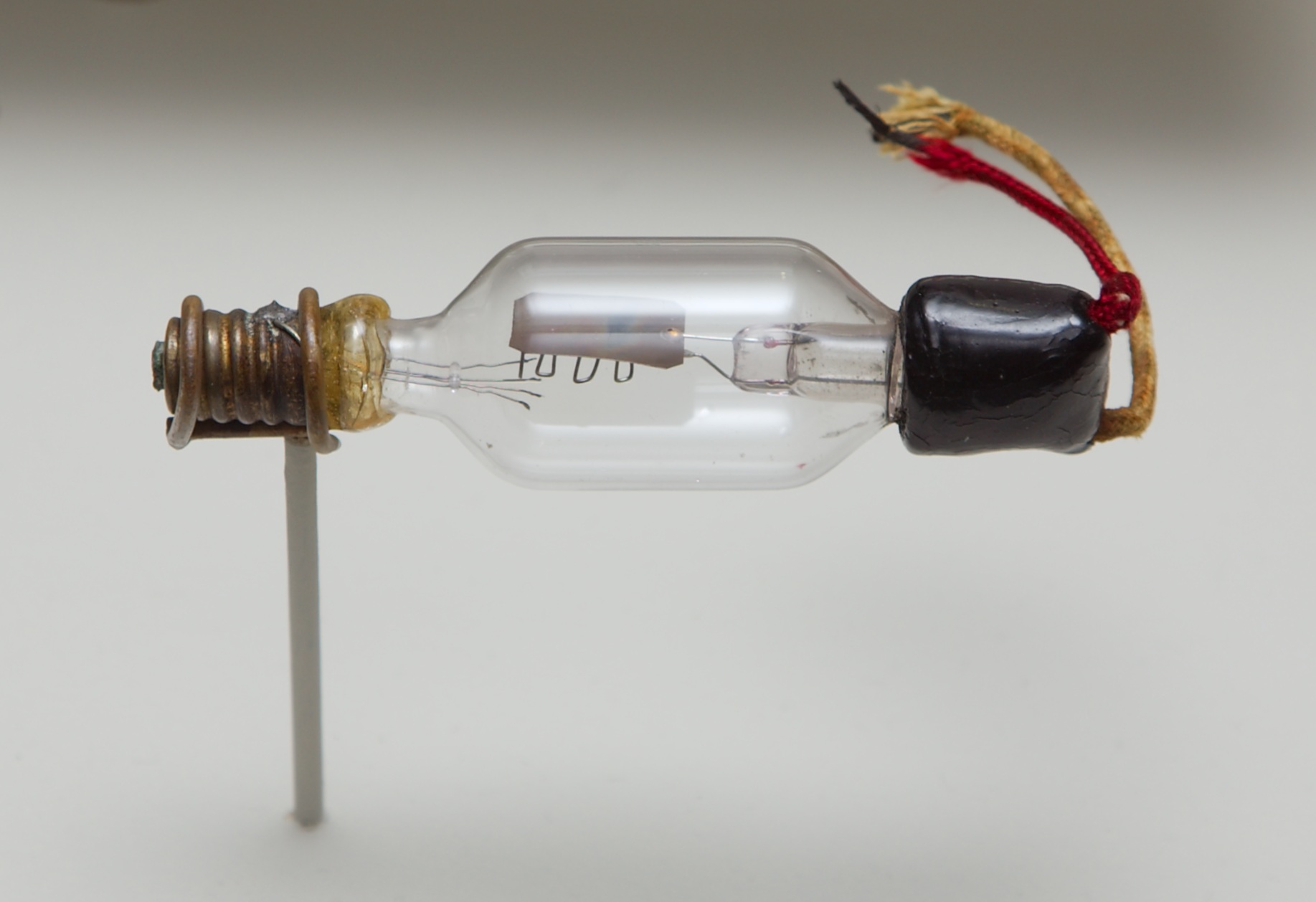|
7199
The 7199 is a vacuum tube, combining a pentode and triode. Typically, the pentode was used for the input stage, and the triode as a phase inverter. The tube was used in a number of American guitar amplifiers; the Gibson Guitar Corporation, for instance, used the 7199 in 1961's Falcon for the reverb circuit. Ampeg Ampeg is a manufacturer best known for its bass amplifiers. Originally established in 1946 in Linden, New Jersey by Everett Hull and Stanley Michaels as "Michael-Hull Electronic Labs," today Ampeg is part of the Yamaha Guitar Group. Although ... also used the 7199 extensively. Notable is the Dynaco ST-70 stereo amplifier introduced in 1959 which used a 7199 tube in the driver section of each channel. Over the next decade more than 350,000 of these amplifiers were produced. American 7199 production ended sometime in the 1980s while the Soviet tube company Sovtek produced one until roughly 2007. As a result the tube is becoming increasingly scarce. Another tube of the s ... [...More Info...] [...Related Items...] OR: [Wikipedia] [Google] [Baidu] |
Gibson Falcon
The Falcon (GA-19RVT) was a guitar amplifier made by Gibson Guitar Corporation in 1961. With the Falcon and a few other models, Gibson was ahead of Fender in bringing an amplifier with reverb on the market. In addition, the Falcon also had tremolo. The Falcon got 14 watts out of two 6V6 tubes (the same tubes used in the comparable Fender Deluxe), and had a Jensen 12" speaker. The pre-amp was powered by three 6EU7 tubes, and a 7199 The 7199 is a vacuum tube, combining a pentode and triode. Typically, the pentode was used for the input stage, and the triode as a phase inverter. The tube was used in a number of American guitar amplifiers; the Gibson Guitar Corporation, for insta ... for the reverb circuit. It also has a 5V3GT rectifier tube in the V7 socket. Unlike Fender's later reverb amps (such as the Princeton Reverb), the Falcon had a fairly unusual placement of the reverb circuit: rather than being placed after the pre-amp section and having the wet signal mixed with the dry, ... [...More Info...] [...Related Items...] OR: [Wikipedia] [Google] [Baidu] |
Vacuum Tube
A vacuum tube, electron tube, valve (British usage), or tube (North America), is a device that controls electric current flow in a high vacuum between electrodes to which an electric voltage, potential difference has been applied. The type known as a thermionic tube or thermionic valve utilizes thermionic emission of electrons from a hot cathode for fundamental electronic functions such as signal amplifier, amplification and current rectifier, rectification. Non-thermionic types such as a vacuum phototube, however, achieve electron emission through the photoelectric effect, and are used for such purposes as the detection of light intensities. In both types, the electrons are accelerated from the cathode to the anode by the electric field in the tube. The simplest vacuum tube, the diode (i.e. Fleming valve), invented in 1904 by John Ambrose Fleming, contains only a heated electron-emitting cathode and an anode. Electrons can only flow in one direction through the device—fro ... [...More Info...] [...Related Items...] OR: [Wikipedia] [Google] [Baidu] |
Pentode
A pentode is an electronic device having five electrodes. The term most commonly applies to a three-grid amplifying vacuum tube or thermionic valve that was invented by Gilles Holst and Bernhard D.H. Tellegen in 1926. The pentode (called a ''triple-grid amplifier'' in some literature) was developed from the ''screen-grid tube'' or ''shield-grid tube'' (a type of tetrode tube) by the addition of a grid between the screen grid and the plate. The screen-grid tube was limited in performance as an amplifier due to secondary emission of electrons from the plate. The additional grid is called the ''suppressor grid''. The suppressor grid is usually operated at or near the potential of the cathode and prevents secondary emission electrons from the plate from reaching the screen grid. The addition of the suppressor grid permits much greater output signal amplitude to be obtained from the plate of the pentode in amplifier operation than from the plate of the screen-grid tube at the same plate ... [...More Info...] [...Related Items...] OR: [Wikipedia] [Google] [Baidu] |
Triode
A triode is an electronic amplifying vacuum tube (or ''valve'' in British English) consisting of three electrodes inside an evacuated glass envelope: a heated filament or cathode, a grid, and a plate (anode). Developed from Lee De Forest's 1906 Audion, a partial vacuum tube that added a grid electrode to the thermionic diode (Fleming valve), the triode was the first practical electronic amplifier and the ancestor of other types of vacuum tubes such as the tetrode and pentode. Its invention founded the electronics age, making possible amplified radio technology and long-distance telephony. Triodes were widely used in consumer electronics devices such as radios and televisions until the 1970s, when transistors replaced them. Today, their main remaining use is in high-power RF amplifiers in radio transmitters and industrial RF heating devices. In recent years there has been a resurgence in demand for low power triodes due to renewed interest in tube-type audio systems by audiophi ... [...More Info...] [...Related Items...] OR: [Wikipedia] [Google] [Baidu] |
Gibson Guitar Corporation
Gibson Brands, Inc. (formerly Gibson Guitar Corporation) is an American manufacturer of guitars, other musical instruments, and professional audio equipment from Kalamazoo, Michigan, and now based in Nashville, Tennessee. The company was formerly known as Gibson Guitar Corporation and renamed Gibson Brands, Inc. on June 11, 2013. Orville Gibson started making instruments in 1894 and founded the company in 1902 as the Gibson Mandolin-Guitar Mfg. Co. Ltd. in Kalamazoo, Michigan, to make mandolin-family instruments. Gibson invented archtop guitars by constructing the same type of carved, arched tops used on violins. By the 1930s, the company was also making flattop acoustic guitars, as well as one of the first commercially available hollow-body electric guitars, used and popularized by Charlie Christian. In 1944, Gibson was bought by Chicago Musical Instruments (CMI), which was acquired in 1969 by Panama-based conglomerate Ecuadorian Company Limited (ECL), that changed its name ... [...More Info...] [...Related Items...] OR: [Wikipedia] [Google] [Baidu] |
Vintage Guitar (magazine)
''Vintage Guitar'' is an American magazine that focuses on vintage and classic guitars, amplifiers, effects, and related equipment, as well as notable guitarists from all genres and eras. The publication's feature stories and monthly columns cover a diverse range of topics by contributors, including some of the biggest names in the industry and renowned authorities like Dan Erlewine, George Gruhn, Wolf Marshall, Richard Smith, and Seymour W. Duncan, as well as some of the best-known writers in the field, including Pete Prown, Walter Carter, Dan Forte, Dave Hunter, Rich Kienzle, Michael Dregni, John Peden, Greg Prato, and others. The magazine's classified-ad section provides readers with access to classic, used and new guitars, amps, accessories, books, videos, and more. Other editorial content focuses on reviews of music as well as informed, objective reviews of new gear. ''Vintage Guitar'' also includes monthly repair columns written by noted repair expert/luthier Dan Erlewine. ... [...More Info...] [...Related Items...] OR: [Wikipedia] [Google] [Baidu] |
Ampeg
Ampeg is a manufacturer best known for its bass amplifiers. Originally established in 1946 in Linden, New Jersey by Everett Hull and Stanley Michaels as "Michael-Hull Electronic Labs," today Ampeg is part of the Yamaha Guitar Group. Although specializing in the production of bass amplifiers, Ampeg has previously manufactured guitar amplifiers and pickups and instruments including double basses, bass guitars, and electric guitars. History Early years (1946―1959) Everett Hull (born Charles Everitt Hull), a pianist and bassist from Wisconsin working with bandleader Lawrence Welk in Chicago, had invented a pickup for upright bass in an effort to amplify his instrument with more clarity. Hull's design placed a transducer atop a support peg inside the body of his instrument, inspiring his wife Gertrude to name the invention the "Ampeg," an abbreviated version of "amplified peg." On February 6, 1946, Hull filed a patent application for his "sound amplifying means for strin ... [...More Info...] [...Related Items...] OR: [Wikipedia] [Google] [Baidu] |



